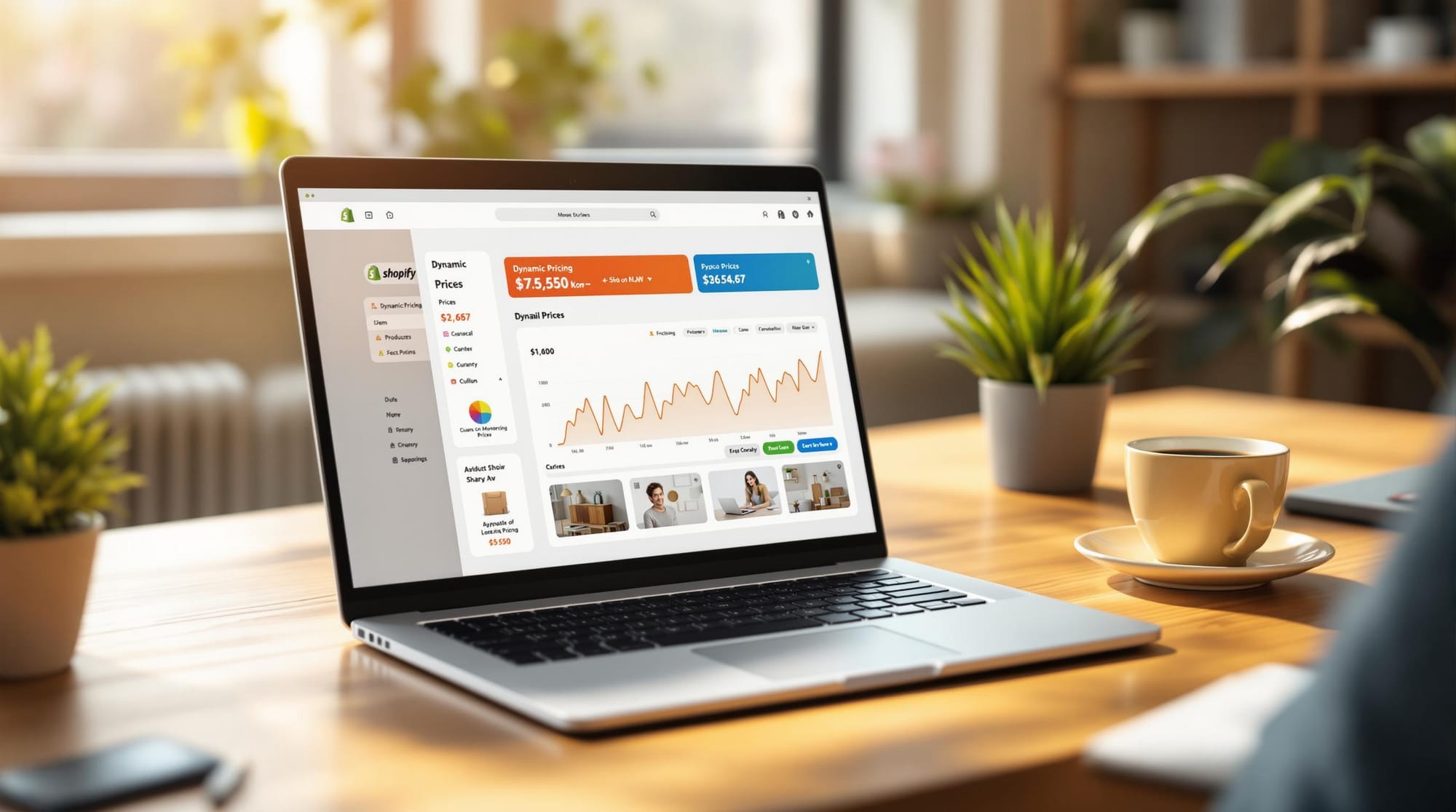How to Set Up Dynamic Pricing in Shopify
Learn how to implement dynamic pricing in Shopify to optimize revenue, manage inventory, and enhance customer experience seamlessly.

Dynamic pricing in Shopify lets you adjust product prices automatically based on factors like demand, stock levels, and competitor pricing. This strategy can boost revenue, improve inventory management, and help you stay competitive. Here’s a quick guide:
- Benefits: Increases profits, reduces overstock, and enables personalized pricing.
- Tools Needed: Use Shopify apps like Dynamic Markup or Addify's Dynamic Pricing for real-time adjustments, bulk discounts, and analytics.
- Steps to Implement:
- Choose a dynamic pricing app and integrate it with your Shopify store.
- Set pricing rules (e.g., inventory-based, competitor-driven, seasonal).
- Test changes on a small scale and monitor performance.
- Best Practices: Define price limits, stay transparent with customers, and regularly review your strategy.
Pair dynamic pricing with cart optimization tools like CRO Cart Drawer & Cart Upsells to enhance customer experience and increase conversions. These tools offer features like AI-powered upsells, dynamic progress bars, and personalized discounts directly in the cart.
Dynamic pricing, combined with smart cart strategies, can help you maximize revenue while maintaining customer trust.
Selecting a Dynamic Pricing Tool for Shopify

Key Features of a Dynamic Pricing Tool
When choosing a pricing tool, look for features like real-time price adjustments, inventory-based rules, custom pricing options, and seamless Shopify integration. These tools should also provide detailed analytics to help you stay competitive, manage inventory efficiently, and make informed pricing decisions tailored to your audience.
Examples of Dynamic Pricing Tools for Shopify
For Shopify merchants, it's important to pick a tool that fits your specific needs. For instance:
- Dynamic Markup: Adjusts prices based on inventory levels .
- Addify's Dynamic Pricing: Offers bulk discounts and customer-specific pricing .
To get the most out of these tools, think about combining them with cart optimization features. These can include:
- Progress bars and AI-driven recommendations
- Personalized upsells tied to pricing rules
- Free gifts offered at specific price thresholds
These additions create a smoother shopping experience while boosting revenue. When evaluating dynamic pricing tools, pay attention to:
- How well they allow testing of different pricing strategies
- Their performance tracking and analytics features
- Flexibility to adjust rules based on results
- Compatibility with your store's existing setup
Pairing dynamic pricing with cart optimization strategies can help you offer personalized incentives, increase average order value, and maintain a smart pricing structure. After selecting the right tool, focus on implementing it effectively to unlock its full potential.
Steps to Set Up Dynamic Pricing in Shopify
Setting Up the Dynamic Pricing Tool
Start by selecting a dynamic pricing app from the Shopify App Store that fits your business needs. Once installed, connect the app to your Shopify store, sync your product catalog, and set up basic pricing preferences like currency and key parameters. Once the tool is ready, you're all set to define pricing rules that align with your business strategy.
Creating Pricing Rules
Craft pricing rules that strike a balance between staying competitive and maintaining profitability. Here are a few common types of rules to consider:
| Rule Type | Description | Example Use Case |
|---|---|---|
| Inventory-Based | Adjusts prices based on stock levels | Raise prices for low-stock items |
| Competitor-Driven | Tracks and matches market rates | Match or undercut competitor prices |
| Time-Sensitive | Adjusts prices by time or season | Offer discounts during holidays |
| Customer-Specific | Tailors pricing for customer groups | Bulk discounts for wholesalers |
Testing and Monitoring Price Changes
Before rolling out dynamic pricing across your entire store, test it on a small group of products. This helps ensure the system works as intended and allows you to fine-tune your approach. Focus on these areas during testing:
- Price Update Accuracy: Confirm that price changes appear correctly across your store.
- Rule Effectiveness: Check how your pricing rules perform in different situations.
- Customer Reaction: Analyze sales trends and customer behavior after price changes.
Keep a close eye on margins and avoid engaging in price wars. Regularly reviewing and adjusting your pricing strategy will help you stay competitive while meeting your business goals.
Managing Dynamic Pricing Effectively
Reviewing Pricing Strategies
Keep an eye on key metrics like revenue, margins, and conversions, while paying close attention to customer behavior and market trends. Regular reviews help fine-tune pricing rules. Set clear limits to safeguard your business:
| Price Adjustment Type | Threshold Example | Purpose |
|---|---|---|
| Minimum Markup | 20% above cost | Avoids selling at a loss |
| Maximum Markup | 150% above cost | Ensures prices stay competitive |
| Daily Change Limit | ±5% per day | Prevents drastic price shifts |
Maintaining Transparency with Customers
Clear communication about pricing practices builds trust and reduces confusion. Here are a few ways to stay transparent:
- Show both the original and adjusted prices, along with explanations (e.g., "Limited stock - 3 items left").
- Notify customers in advance about major price changes.
- Clearly outline shipping thresholds and volume discount rules.
Balancing Profit Margins and Competitiveness
Finding the right balance between profitability and staying competitive requires a data-driven approach. Use insights to avoid common pitfalls like over-discounting or losing margins unnecessarily.
| Factor | Strategy | Impact |
|---|---|---|
| Inventory Levels | Raise prices on items with low stock | Preserves inventory |
| Competitor Pricing | Stay within 5-10% of competitors | Keeps you competitive without eroding profits |
| Seasonal Demand | Adjust markups during busy periods | Captures more revenue |
| Customer Segments | Use tiered pricing for different groups | Balances affordability with profit goals |
"Data analysis is crucial for optimizing dynamic pricing strategies. It helps identify trends, patterns, and correlations that inform pricing decisions, ensuring that prices are set based on real-time market conditions and customer behavior" .
PriceIntelligence AI - Dynamic Pricing App for Shopify
Combining Dynamic Pricing with Cart Optimization
Dynamic pricing works best when paired with tools like CRO Cart Drawer & Cart Upsells, which improve how pricing strategies are displayed and perceived. Together, these tools create a smoother shopping experience, boosting conversions and increasing the average order value.
Improving Conversions with CRO Cart Drawer & Cart Upsells
The success of dynamic pricing often depends on how well offers are presented. CRO Cart Drawer & Cart Upsells ensures offers are delivered quickly and in a way that keeps your store running smoothly, all while tailoring them to each customer.
| Feature | How It Supports Dynamic Pricing |
|---|---|
| AI-Powered Cross-Sells | Recommends relevant products based on cart contents and pricing rules |
| Bulk Discount Display | Shows live savings as customers add more items |
| Dynamic Progress Bar | Tracks progress toward free shipping or gifts |
| 1-Click Cart Upsell | Simplifies adding dynamically priced items to the cart |
Features Supporting Dynamic Pricing
Dynamic pricing shines when paired with tools that update prices in real time and offer personalized deals directly in the cart.
Price Communication
- Free shipping bars and progress trackers adjust instantly, showing how close customers are to unlocking better deals.
- In-cart offer builders highlight discounts tailored to the items already selected.
Performance Optimization
- A/B testing helps find the most effective ways to present offers.
- Tracking tools measure how different combinations of offers impact conversions.
Increasing Revenue with Integrated Strategies
By addressing common obstacles to purchase and meeting customer expectations for fair and personalized pricing, this strategy helps drive revenue growth.
Smart Offer Timing
- Offer free gifts when customers hit specific cart values.
- Automatically apply bulk discounts or special deals based on cart behavior.
Customizable Experience
- Messaging can be tailored to match your brand’s style while appealing to different customer groups.
- Multi-language support makes it easier to connect with shoppers worldwide.
"Data analysis is crucial for optimizing dynamic pricing strategies. It helps identify trends, patterns, and correlations that inform pricing decisions, ensuring that prices are set based on real-time market conditions and customer behavior" .
Conclusion: Using Dynamic Pricing in Shopify
Summary and Next Steps
Dynamic pricing allows Shopify merchants to adjust to market trends while keeping profits intact. When paired with tools like CRO Cart Drawer & Cart Upsells, it becomes even more effective. Features such as bulk discounts, AI-driven suggestions, and real-time tracking create a powerful setup.
Here’s how to get started:
| Action Step | How to Do It |
|---|---|
| Review Current Strategy | Examine your pricing and spot areas for dynamic changes. |
| Set Clear Parameters | Define limits for price adjustments to ensure profitability. |
| Use CRO Cart Drawer & Cart Upsells | Combine dynamic pricing with cart-focused optimization tools. |
| Monitor Performance | Use A/B testing and analytics to track success. |
Make sure to review your pricing approach annually . To maximize your strategy, consider these features:
- Free shipping thresholds to increase cart sizes
- Bulk discounts based on total cart value
- AI-driven product suggestions
- Real-time progress updates
- Personalized offers displayed in the cart
Dynamic pricing, when integrated with cart optimization, enhances the shopping experience and boosts conversion rates. The CRO Cart Drawer & Cart Upsells tool adds to this by offering:
- A fast, seamless cart experience with no redirects
- Flexible, customizable offer displays
- Support for multiple languages
- A/B testing for refining strategies
- Automated upsell suggestions tailored to customer behavior
